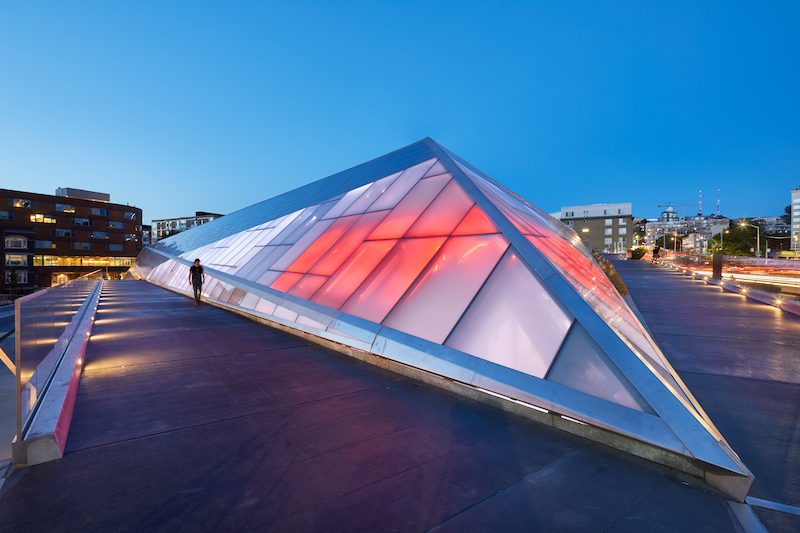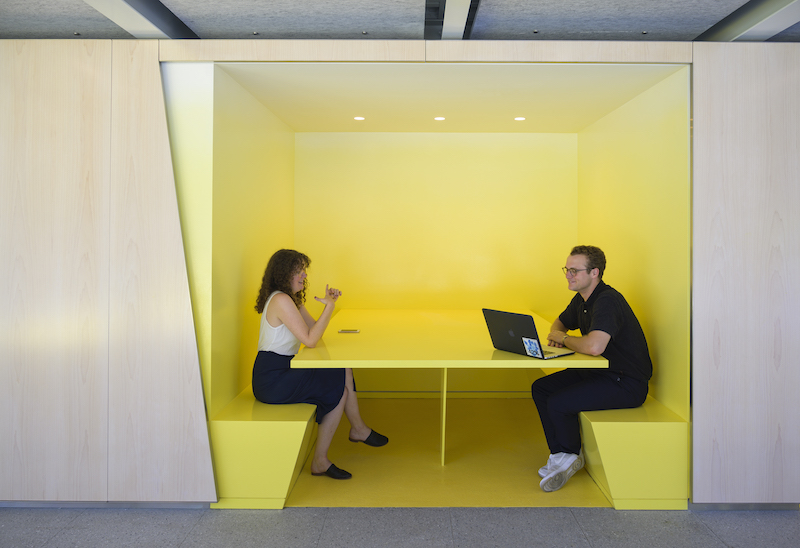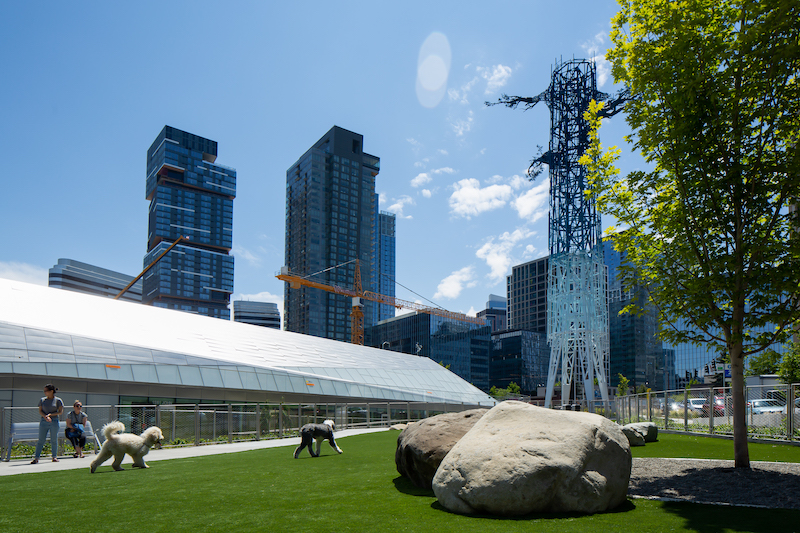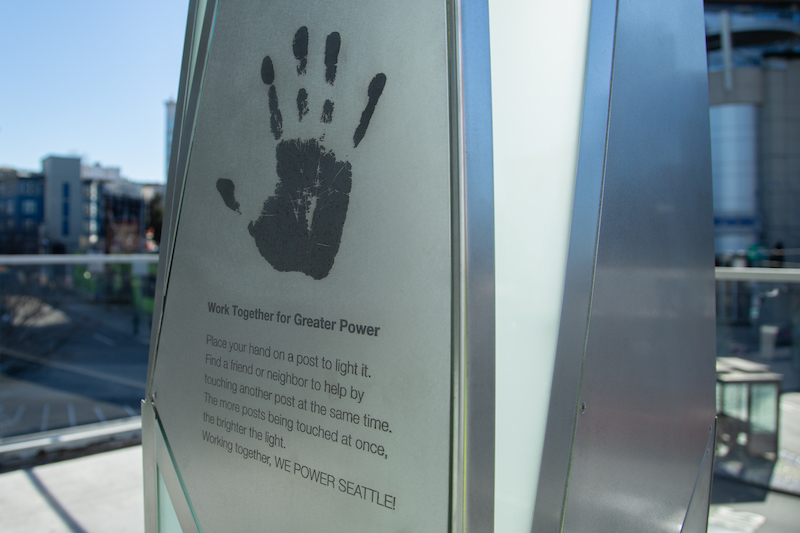Last month, the first substation built in Seattle in three decades opened between that city’s fast-growing South Lake Union area and Denny Triangle.
The Denny Substation officially debuted on July 20. It is the culmination of a three-year construction and multiyear planning and community engagement process between the facility’s designer, NBBJ, and Seattle City Lights, the city-owned electric utility.
The $210 million substation complex—which ran $100 million over its initial cost projections in 2005 due to rising construction costs and increases in the neighborhood's power needs in the ensuing years—covers more than 120,000 sf within a block and a half of real estate where a former Greyhound bus maintenance terminal once stood. The complex includes the 10,000-sf substation with slanted, stainless-steel walls that pick up color from sunlight and the sky. Translucent glass panels emit a soft glow when illuminated at night. Ambient light is strategically placed to brighten the building’s interior space.
 Panels allow visitors to see into the facility, and highlights the centrality of energy in the neighborhood's vitality. Image: Benjamin Benschneider
Panels allow visitors to see into the facility, and highlights the centrality of energy in the neighborhood's vitality. Image: Benjamin Benschneider
Translucent and transparent walls, 35 feet high, allow visitors to view directly into the substation. This feature is meant to remind the public about the production and importance of energy and power in daily life. Indeed, what makes this project unique is how it has been designed to be friendly to users and the community at large.
ALSO SEE: Energizing the Neighborhood
There’s an ADA-compliant elevated diagonal walkway, one-quarter mile long, that wraps around the building. The west side of the site includes a 44,000-sf public green with an off-leash dog park and space for food trucks.
 Part of the Community Meeting Space inside the Denny Substation. Image: Ryne Hill and NBBJ
Part of the Community Meeting Space inside the Denny Substation. Image: Ryne Hill and NBBJ
Inside the substation are a 3,900-sf Community Meeting Space, and a 2,900-sf Energy Inspiration Space, with a pantry, offices, immersive theater, activity zone, and exhibition space. The substation has its own public art program that incorporates permanent artworks, temporary pieces, and ongoing cultural and artistic programming.
The Denny Substation, powered mostly by hydroelectric energy, is projected to be Net Positive, generating 105% of the energy needs and projected to achieve an Energy Use Intensity level of 15.5, on par with Seattle’s Bullitt Center, one of the country’s greenest office buildings. The substation is targeting Petal Certification from the Living Building Challenge.
 An off-leash dog park is part of the public space within the substation's premises. Image: NBBJ
An off-leash dog park is part of the public space within the substation's premises. Image: NBBJ
 An interactive kiosk allows visitors to illuminate a post, thereby emphasizing the interaction between residents and power sources. Image: NBBJ
An interactive kiosk allows visitors to illuminate a post, thereby emphasizing the interaction between residents and power sources. Image: NBBJ
Related Stories
| Nov 10, 2010
$700 million plan to restore the National Mall
The National Mall—known as America’s front yard—is being targeted for a massive rehab and restoration that could cost as much as $700 million (it’s estimated that the Mall has $400 million in deferred maintenance alone). A few of the proposed projects: refurbishing the Grant Memorial, replacing the Capitol Reflecting Pool with a smaller pool or fountain, reconstructing the Constitution Gardens lake and constructing a multipurpose visitor center, and replacing the Sylvan Theater near the Washington Monument with a new multipurpose facility.
| Nov 9, 2010
Designing a library? Don’t focus on books
How do you design a library when print books are no longer its core business? Turn them into massive study halls. That’s what designers did at the University of Amsterdam, where they transformed the existing 27,000-sf library into a study center—without any visible books. About 2,000 students visit the facility daily and encounter workspaces instead of stacks.
| Nov 3, 2010
Park’s green education center a lesson in sustainability
The new Cantigny Outdoor Education Center, located within the 500-acre Cantigny Park in Wheaton, Ill., earned LEED Silver. Designed by DLA Architects, the 3,100-sf multipurpose center will serve patrons of the park’s golf courses, museums, and display garden, one of the largest such gardens in the Midwest.
| Nov 3, 2010
Sailing center sets course for energy efficiency, sustainability
The Milwaukee (Wis.) Community Sailing Center’s new facility on Lake Michigan counts a geothermal heating and cooling system among its sustainable features. The facility was designed for the nonprofit instructional sailing organization with energy efficiency and low operating costs in mind.
| Nov 3, 2010
New church in Connecticut will serve a growing congregation
Tocci Building Companies will start digging next June for the Black Rock Congregational Church in Fairfield, Conn. Designed by Wiles Architects, the 103,000-sf multiuse facility will feature a 900-person worship center with tiered stadium seating, a children’s worship center, a chapel, an auditorium, a gymnasium, educational space, administrative offices, commercial kitchen, and a welcome center with library and lounge.
| Nov 2, 2010
Cypress Siding Helps Nature Center Look its Part
The Trinity River Audubon Center, which sits within a 6,000-acre forest just outside Dallas, utilizes sustainable materials that help the $12.5 million nature center fit its wooded setting and put it on a path to earning LEED Gold.
| Oct 13, 2010
Editorial
The AEC industry shares a widespread obsession with the new. New is fresh. New is youthful. New is cool. But “old” or “slightly used” can be financially profitable and professionally rewarding, too.
| Oct 13, 2010
Biloxi’s convention center bigger, better after Katrina
The Mississippi Coast Coliseum and Convention Center in Biloxi is once again open for business following a renovation and expansion necessitated by Hurricane Katrina.
| Oct 13, 2010
Tower commemorates Lewis & Clark’s historic expedition
The $4.8 million Lewis and Clark Confluence Tower in Hartford, Ill., commemorates explorers Meriwether Lewis and William Clark at the point where their trek to the Pacific Ocean began—the confluence of the Mississippi and Missouri Rivers.
| Oct 13, 2010
Residences bring students, faculty together in the Middle East
A new residence complex is in design for United Arab Emirates University in Al Ain, UAE, near Abu Dhabi. Plans for the 120-acre mixed-use development include 710 clustered townhomes and apartments for students and faculty and common areas for community activities.
















